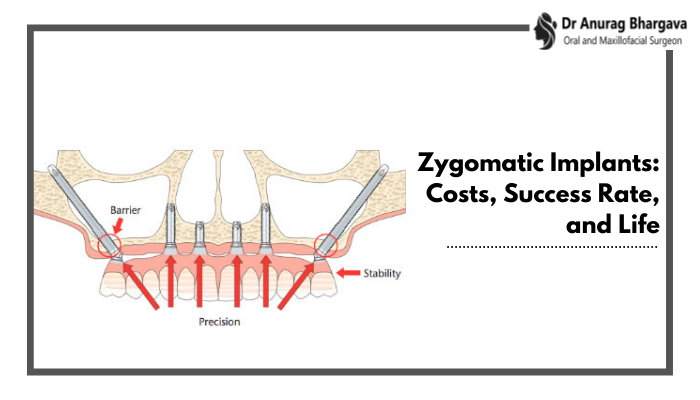Zygomatic implants may be the newcomer in the world of fixing damaged or missing teeth, but these have proven effective in a lot of applications and have exceedingly high success rates. They have been especially popular with those who aren’t eligible to get traditional dental implants.
What are Zygomatic Implants?
Zygomatic implants are implanted into the zygomatic bone (the cheekbone) and used to replace the teeth in the upper jaw. Whether it's a few loose teeth (which can happen because of severe periodontal disease), teeth that are severely damaged (or even decayed), or an entire arch of missing teeth, these implants make it happen. When used with traditional implants, they can be used to replace both upper and lower teeth. And if you don't have enough bone mass so that you can get traditional dental implants, It is still an option! This is because unlike traditional implants, where the implant fuses with the maxillary bone, it can fixed into the zygomatic bone (bone which doesn't lose bone mass because of missing teeth or periodontal disease, and is denser than the maxillary bone). And because of being implanted in the cheekbones, it is longer than traditional implants.
Benefits of a Zygomatic Implant
Developed in the 1990s, even though these are a relatively new treatment option to fix broken or missing teeth, they have a number of benefits over traditional dental implants:
- Can be used to replace loose teeth, severely damaged/decayed teeth, and arch of missing teeth.
- They are implanted into the cheekbone, which is denser than the maxillary bone, so it provides a solid anchor point for the implant.
- Some patients have bone loss (due to factors like missing teeth, periodontal disease, aging, trauma, tumor resection, or atrophy), and can't get traditional implants, but they can still get zygomatic implants because the zygomatic bone doesn't lose bone mass.
- Supplementary procedures like a sinus lift are not necessary when fixing these implants if the upper jaw has low bone mass. This means the treatment will be shorter, more comfortable, and cheaper.
- Because the zygomatic bone is dense and the implants are placed at an angle, you won't have to wait for the implants to heal. Because dental prosthetics can immediately be loaded onto the implants during surgery, you won't have to go without teeth while your implants heal.
- Depending on the amount of bone loss, it can be used with 2-4 traditional implants to fix everything
They have a 97-98% success rate.
How much do Zygomatic Implants Cost?
It can cost around ₹50,000 to ₹90,000 for each implant. When used along with multiple traditional implants and dental prosthesis, the entire procedure will end up costing more.
Success Rate: Are Zygomatic Implants Safe?
Zygomatic dental implants have a high success rate- around 96-98%. It is a safe and effective procedure with its own merits, but is not exempt from risks and complications. The most common complications of getting a zygomatic implant are sinusitis, paresthesia, and oro-antral fistula. Although sinusitis occurring after getting a zygomatic implant can be corrected, it can be difficult to correct it, and it is possible that you may lose the implant. Other possible complications:
- Vestibular cortical fenestration
- Temporary sensory nerve deficits
- Orbital penetration and injury
- Subconjunctival and periorbutal
- Intraoral soft tissue problems
- Moderate nasal bleeding
- Subcutaneous malar emphysema
- Problems with speech and oral hygiene
How Long Do They Last?
Not only is this a safe and effective procedure, zygomatic implants have a survival rate of 96% after 12 years. That's pretty great! So while these are not all that common yet, zygomatic implants are a brilliant development in the world of dental implants that lets you get implants even if you are suffering from bone loss.

